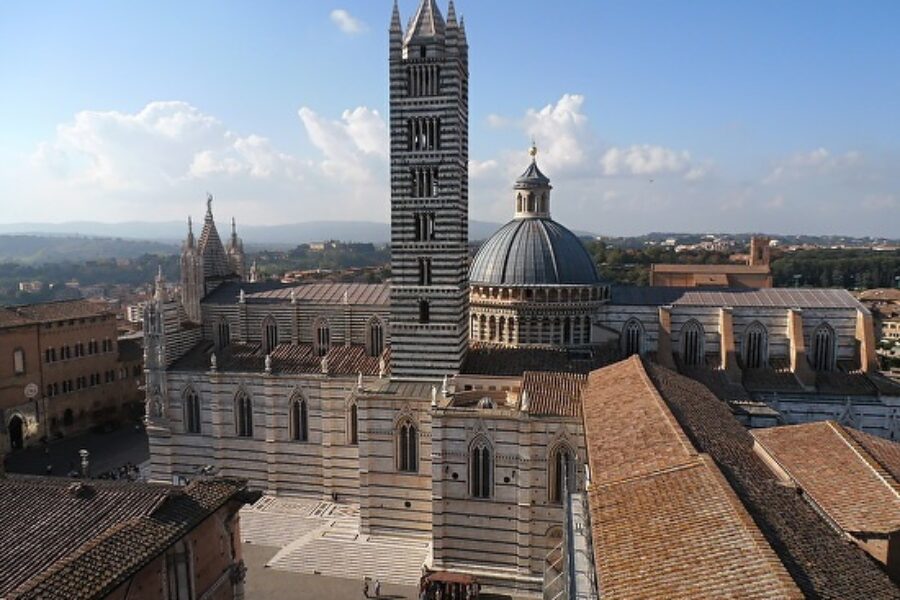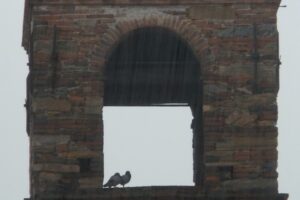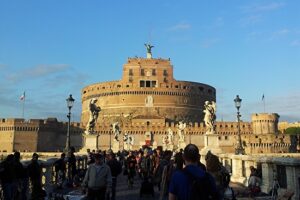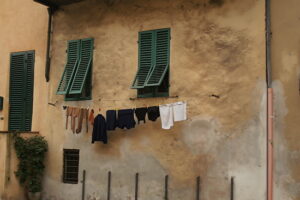Sienna Stumble

Leaving the bus at the foot of centro storico in Siena, Michael immediately crosses the street and begins walking away from where I feel we should be walking toward. I follow.
We weave our way through the Wednesday market, finally leaving the vendors behind, venturing into a large brick complex surrounded by trees — with no way out — except over the wall, down a ravine, and up a hill.
Tentatively I ask, “Do you know where you are going.”
His reply is hard to refute, “We’re here to see Siena, right?”
Our yins and yangs are not happy with each other; our priorities are totally out of sync. Me, I want to find our hotel, get settled, and then explore. Michael doesn’t seem to care.
Even though it is late October, upon entering Centro Storico we are bombarded with hordes of tourists, all in a jumble. I hear every language but Italian. The thought crosses my mind that is that if this is la dolce vita, I’m not sure I want to live it. We trudge on, dragging our minuscule suitcase behind us.
Finding Palazzo Fani Mignanelli

Finally, after going from high ground to low ground to high ground to low ground and back again; after many steps, missteps, unsure steps, incorrect steps, and retraced steps; and after buying a map, we find it – Palazzo Fani Mignanelli. Near Il Campo through a flower shop and up an elevator to the third floor, through a door, down some more steps, and through another door. There it is. Kind of. We walk up more steps that turn and twist. Down a hall. We stop. Michael inserts our newly acquired key.
The hotel works for us. It is in a very central location. The water pressure is great. The showers, HOT. The bed linens are of good quality and freshly ironed, as are the hand linens in the bathroom. There is a beam in our fifth-floor room as old and almost as big as Siena. And there is a comfortable love seat in which we sit and try to figure things out, like — How did we get so turned around?
Lunch in Il Campo
Traveling since 7:30 a.m., by foot, by train, by bus, and by foot again, we are starved. Out on the street we head for lunch on Il Campo, even though we have been forewarned that the food is mediocre, the waiters unfriendly, and the prices high. However, what the food lacks in quality, it makes up for in quantity.
We drink. We eat. Shaking our heads, we laugh at ourselves.





The first time I read about Sienna and the infamous horse races, The Palio di Siena, was when I read Herman Wouk’s The Winds of War. It is the wrong time of year, not August, but signs fill the streets.



Il Duomo
We discover il duomo, the metropolitan cathedral of Siena. The entire church complex is massive; each section requires its own tour with more euros for each. The façade is a wedding cake. It is spires, curlicues, statues, and mosaics. It is all immensity and amazement. I could sit and look in wonder all day long. Michael purchases two tickets for a tour and urges me from my vantage point on the stone bench. Stepping inside the duomo I am overwhelmed. I am diminished. It is sensory overload.







The Bell Tower vs the Museum
While Michael climbs the bell tower of Il Duomo, I opt for other pastimes. A museum is part of the cathedral complex and it calls my name. There is a statue of Aristotle; he is a cute kind of guy. Then there is Plato. Not so cute. I snap pictures in a chamber of many statues standing in a row. On my way upstairs to see other wonders, too late I notice a picture of a camera with a big red X crossed through it.
Days End



At night I lay in bed awake for hours. The window — open to the moonlight — allows the sound of revelers to drift up from Il Campo. Singing. Laughing. Yelling. Till 3:45 a.m.
The tolling bells in the tower keep me informed.
Day 2
Before Michael can suggest another tower we begin the day exploring Sienna, the Italian city everyone seems to love. I love the markets.


Michael loves the details.







Torre del Mangia
After another touristy lunch in Il Campo, Michael informs me the tower awaits. At more than 500 steps (according to what I read) I politely decline (“Are you crazy?”) once again, and continue sitting at a bar bordering Il Campo, drinking and eating until he returns.
The Torre del Mangia, built in 1338-1348 was one of the tallest secular towers in medieval Italy. Emulating Islamic architecture with its square minaret design, pointed arches, and height, the tower was built to be exactly the same height as Il Duomo as a sign that the church and the state had equal power.


Siena deserves more than are able to give. Two nights are not enough.









Leave a Reply
Your email is safe with us.